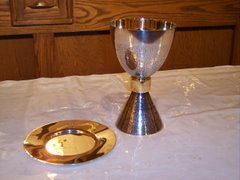The Church of the Resurrection isn't doing a Great Vigil this year, and hasn't for several years. However, I hope for us to grow into this tradition soon. It's an important liturgy because in its drama, theology, and form it is literally the mother of all Eucharists. It is the most dramatic ritual the church performs all year because we do spectacular things. We light fire. We read up to nine pieces of the most dramatic stories from scripture, and there is freedom to be creative with these readings. I've experienced James Weldon Johnson's Creation poem from God's Trombones used as the creation reading. Abstract paintings depicting the creation unveiled during the creation reading. Water poured into a metal bowl, intentionally loud, during the parting of the waters reading from exodus. The dry bones of Ezkiel come alive with a dramatic reading by a woman as God and a man as Ezekiel with percussion playing the back ground. All this happens in a darkened church. It is symbolic and mimetic. We remember the story, the history of God's salvation that comes to us while we are still in the darkness of sin in the darkened church. Then the lights come up suddenly inaugurating the new life of Easter, the new life available to us in the risen Christ.
The new life in Christ is the theological statement of the service. Dr. Jim Farewell writes in his book This is the Night, "The Great Vigil begins in the darkness of Easter eve, sometime between sunset on Saturday and sunrise on Easter morning. The celebrant initiates the liturgy with this address to the people, in which the gathering is caught up in the mystery of the passing over into freedom of the people of Israel and the passing over of Jesus from Death to Life:(61)"
Dear friends in Christ: On this most holy night, in which our Lord Jesus passed over from death to life, the Church invites her members, dispersed throughout the world, to gather in vigil and prayer. For this is the Passover of the Lord, in which, by hearing his Word and celebrating his Sacraments, we share in his victory over death.(BCP 1979)
By immersing ourselves liturgically in the salvation history and the life, death, and resurrection of Jesus we are caught up in that new life, that new creation of which scripture tells us the Risen Lord is the first born. Our regular Sunday Eucharists are an extension of this active participation in salvation history. The Vigil births the regular Sunday Eucharistic celebration. The form of the service has four parts: the Lighting of the New Fire and Exsultet; the Vigil Readings; Holy Baptism; and the Holy Eucharist. Our regular Sunday Eucharists are intentionally similar in form though scaled down somewhat. The procession and entrance rite on Sunday morning relates to the New Fire and Exsultat; the service of the word and sermon are a reflection on the Salvation history like the Vigil Readings; when we say the Creed on Sundays it is a remembrance of our Baptism; and the Eucharist is always a re-membrance, a putting back together of the body of Christ just as it is on Easter eve.
The drama, the theology, and the form of the Easter Vigil make it a bold pronouncement of God's Grace and an overwhelming experience for God's people. Therefore I hope that the Church of the Resurrection will start a tradition of the Great Vigil of Easter in the future.
The meditation is also posted on the website of the Church of the Resurrection.

No comments:
Post a Comment